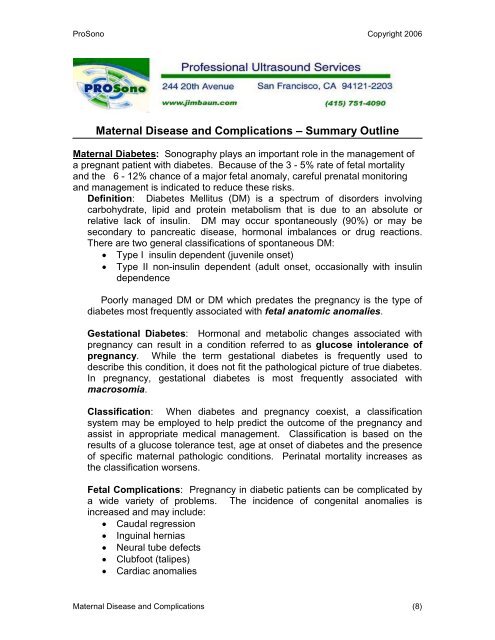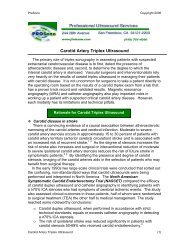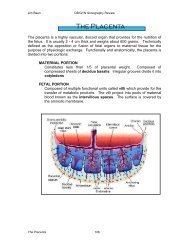Maternal Disease and Complications –Summary Outline
Maternal Disease and Complications –Summary Outline
Maternal Disease and Complications –Summary Outline
You also want an ePaper? Increase the reach of your titles
YUMPU automatically turns print PDFs into web optimized ePapers that Google loves.
ProSono Copyright 2006<br />
<strong>Maternal</strong> <strong>Disease</strong> <strong>and</strong> <strong>Complications</strong> <strong>–Summary</strong> <strong>Outline</strong><br />
<strong>Maternal</strong> Diabetes: Sonography plays an important role in the management of<br />
a pregnant patient with diabetes. Because of the 3 - 5% rate of fetal mortality<br />
<strong>and</strong> the 6 - 12% chance of a major fetal anomaly, careful prenatal monitoring<br />
<strong>and</strong> management is indicated to reduce these risks.<br />
Definition: Diabetes Mellitus (DM) is a spectrum of disorders involving<br />
carbohydrate, lipid <strong>and</strong> protein metabolism that is due to an absolute or<br />
relative lack of insulin. DM may occur spontaneously (90%) or may be<br />
secondary to pancreatic disease, hormonal imbalances or drug reactions.<br />
There are two general classifications of spontaneous DM:<br />
Type I insulin dependent (juvenile onset)<br />
Type II non-insulin dependent (adult onset, occasionally with insulin<br />
dependence<br />
Poorly managed DM or DM which predates the pregnancy is the type of<br />
diabetes most frequently associated with fetal anatomic anomalies.<br />
Gestational Diabetes: Hormonal <strong>and</strong> metabolic changes associated with<br />
pregnancy can result in a condition referred to as glucose intolerance of<br />
pregnancy. While the term gestational diabetes is frequently used to<br />
describe this condition, it does not fit the pathological picture of true diabetes.<br />
In pregnancy, gestational diabetes is most frequently associated with<br />
macrosomia.<br />
Classification: When diabetes <strong>and</strong> pregnancy coexist, a classification<br />
system may be employed to help predict the outcome of the pregnancy <strong>and</strong><br />
assist in appropriate medical management. Classification is based on the<br />
results of a glucose tolerance test, age at onset of diabetes <strong>and</strong> the presence<br />
of specific maternal pathologic conditions. Perinatal mortality increases as<br />
the classification worsens.<br />
Fetal <strong>Complications</strong>: Pregnancy in diabetic patients can be complicated by<br />
a wide variety of problems. The incidence of congenital anomalies is<br />
increased <strong>and</strong> may include:<br />
Caudal regression<br />
Inguinal hernias<br />
Neural tube defects<br />
Clubfoot (talipes)<br />
Cardiac anomalies<br />
<strong>Maternal</strong> <strong>Disease</strong> <strong>and</strong> <strong>Complications</strong> (8)
ProSono Copyright 2006<br />
Single umbilical artery<br />
Renal anomalies<br />
Polydactyly<br />
Gastrointestinal anomalies<br />
Skeletal anomalies<br />
Diabetes also has a significant impact on birth weight of the infant. In<br />
addition to anatomic abnormalities, other fetal complications associated<br />
with diabetes include:<br />
Respiratory distress syndrome<br />
Hypoglycemia (20 - 60%)<br />
IUGR (with maternal DM pre-dating the pregnancy)<br />
Macrosomia (with gestational diabetes)<br />
Hypocalcemia<br />
<strong>Maternal</strong> <strong>Complications</strong>: In addition to fetal complications, associated<br />
maternal complications of diabetes include:<br />
Polyhydramnios (31%)<br />
Preeclampsia (6 - 25%)<br />
Renal dysfunction (2 - 12%)<br />
Hypoglycemia<br />
Peripheral vascular disease<br />
Increased risk of infection<br />
Postpartum hemorrhage<br />
Sonographic Findings:<br />
Fetal Anatomy<br />
Presence of an associated anatomic abnormality<br />
Single umbilical artery<br />
Oligo or polyhydramnios depending on type of fetal anomaly present<br />
Placental Changes<br />
Thickened placenta<br />
Premature aging<br />
Growth Related Changes<br />
IUGR (see section on intrauterine growth restriction)<br />
Macrosomia (more common in Classes A - C). Defined as:<br />
Fetal weight > 4,000 grams or<br />
Birth weight > 90th percentile for gestational age<br />
Associated with:<br />
Hydrops fetalis<br />
Polyhydramnios<br />
Stillbirth<br />
Birth trauma<br />
<strong>Maternal</strong> <strong>Disease</strong> <strong>and</strong> <strong>Complications</strong> (8)
ProSono Copyright 2006<br />
Hypertensive Disorders: <strong>Maternal</strong> <strong>and</strong> fetal complications may result if high<br />
blood pressure remains uncontrolled during pregnancy.<br />
Definition: Hypertension is diagnosed when one of the following criteria is<br />
met:<br />
Systolic pressure > 140 mmHG<br />
Increase in systolic pressure of > 30 mmHg (over the pre-pregnant<br />
state)<br />
Diastolic pressure > 90 mmHG<br />
Diastolic pressure increase > 15 mmHG (over the pre-pregnant state)<br />
Careful monitoring of the blood pressure during pregnancy is important in<br />
preventing the onset of preeclampsia/eclampsia. Classifications:<br />
Essential hypertension: the condition exists prior to pregnancy<br />
P I H D: pregnancy induced hypertensive disorder<br />
Toxemia: A disorder of pregnancy characterized by proteinuria, hypertension<br />
<strong>and</strong> neurological symptoms. Traditionally referred to as "toxemia of<br />
pregnancy", it is more accurately defined as GEPH - Gestational Edema<br />
Proteinuria Hypertensive syndrome. It most commonly occurs in<br />
primigravidas <strong>and</strong> is more common with multiple gestations. Diagnosis <strong>and</strong><br />
treatment of preeclampsia is necessary to prevent progression into life<br />
threatening eclampsia.<br />
Preeclampsia<br />
Hypertension<br />
Generalized edema<br />
Proteinuria<br />
Eclampsia: In addition to HTN, edema <strong>and</strong> proteinuria found in<br />
preeclampsia:<br />
Coma<br />
Seizures<br />
Conditions associated with increased incidence of GEPH include:<br />
Primigravida<br />
Multiple gestations<br />
Vascular disease<br />
Polyhydramnios<br />
Hydatidiform mole<br />
Severe undernutrition<br />
Family history<br />
<strong>Maternal</strong> <strong>Disease</strong> <strong>and</strong> <strong>Complications</strong> (8)
ProSono Copyright 2006<br />
Pathology: A broad spectrum of pathologic entities is associated with<br />
pregnancy induced hypertensive disorder including:<br />
Abnormal vasospasm leading to hypoxia <strong>and</strong>/or necrosis<br />
Premature placental aging<br />
Renal cellular damage<br />
Disseminated intravascular coagulopathy (DIC)<br />
Periportal hemorrhagic necrosis (liver)<br />
Cerebral edema<br />
Pulmonary edema<br />
Clinical Findings:<br />
Hypertension<br />
Sudden, excessive weight gain (> 5lb/1week)<br />
Ankle swelling<br />
Generalized edema<br />
Headaches<br />
Abdominal pain, vomiting<br />
Sonographic Findings:<br />
IUGR<br />
Oligohydramnios<br />
Decreased placental volume<br />
Accelerated placental aging<br />
Fetal demise<br />
Sonography is used to monitor the pregnancy <strong>and</strong> track fetal growth<br />
<strong>Maternal</strong> Infections: Any severe, systemic maternal infection may cause<br />
spontaneous abortion, fetal death <strong>and</strong> premature labor <strong>and</strong> delivery. Growth<br />
restriction may result from chronic infections. Fetal abnormalities can be caused<br />
by several acute infections. The most common significant in utero infections are<br />
the TORCH infections:<br />
Toxoplasmosis<br />
Other (syphilis, etc.)<br />
Rubella<br />
Cytomegalovirus<br />
Herpes<br />
Toxoplasmosis: Caused by a protozoa, T. gondii, which is commonly<br />
found in cat feces <strong>and</strong> uncooked meat. <strong>Maternal</strong> infection, which<br />
crosses the placental barrier <strong>and</strong> results in fetal infection, may cause:<br />
CNS calcifications<br />
Microphthalmia<br />
IUGR<br />
Chorio-retinitis<br />
<strong>Maternal</strong> <strong>Disease</strong> <strong>and</strong> <strong>Complications</strong> (8)
ProSono Copyright 2006<br />
Microcephaly<br />
Thrombocytopenia<br />
Hydrocephaly<br />
Jaundice<br />
Thick placenta<br />
Rubella: Also known as German measles. Extremely teratogenic for<br />
the fetus. Exposure during the first 5 weeks is most dangerous.<br />
Defects include:<br />
Cataracts<br />
Congenital heart disease<br />
Deafness<br />
Mental retardation<br />
Cytomegalovirus: Most common infection in pregnancy. Thought to<br />
cause embryonic demise if exposed in the first trimester. May cause:<br />
Spontaneous abortion<br />
IUGR<br />
Fetal ascites<br />
Fetal death<br />
Cranial anomalies<br />
Chest anomalies<br />
Herpes: The virus is usually transmitted to the fetus during vaginal<br />
delivery. Cesarean section is frequently performed in women with<br />
known disease. Infection may cause:<br />
CNS, eye <strong>and</strong> visceral infection<br />
May be asymptomatic<br />
Generalized multiple organ involvement<br />
Fetal death<br />
Parvovirus: A common respiratory viral infection. If there are<br />
maternal infections during pregnancy, the virus can cross the placental<br />
barrier <strong>and</strong> affect the fetus causing:<br />
Pancytopenia<br />
Possible development of hydrops, necessitating PUBS/ fetal<br />
transfusion<br />
<br />
Sonographic Findings: Careful examination of the fetal anatomy should be<br />
performed in any patient presenting with a history of infection during<br />
pregnancy. Knowledge of the specific defects associated with a particular<br />
infection is necessary so that attention is focused on the proper organ<br />
systems.<br />
<strong>Maternal</strong> <strong>Disease</strong> <strong>and</strong> <strong>Complications</strong> (8)
ProSono Copyright 2006<br />
Other <strong>Maternal</strong> <strong>Complications</strong><br />
Incompetent Cervix: also known as painless premature dilatation of the cervix,<br />
it is the inability of the cervix to prevent the premature expulsion of the uterine<br />
contents. May be acquired or congenital <strong>and</strong> is most frequently related to<br />
cervical trauma. Surgical repair of cervical tears following previous vaginal<br />
deliveries may be one cause. Habitual abortion in the 2 nd trimester may be the<br />
only clinical feature.<br />
Sonographic Findings:<br />
Cervical length < 3 cm before 34 weeks<br />
Cervical width > 2 cm in second trimester - MOST RELIABLE<br />
Firm diagnosis cannot always be made using sonography<br />
Diagnosis based on history <strong>and</strong> clinical findings<br />
Bulging membranes<br />
Bladder distention may cause false negative<br />
Pre-term Labor: Onset of labor before 37 weeks. Etiologies include:<br />
Previous uterine surgery<br />
Uterine anomalies<br />
<strong>Maternal</strong> stress<br />
Heavy cigarette smoking<br />
Multiple gestations<br />
Polyhydramnios<br />
Antepartum bleeding (from previa, abruption)<br />
Systemic infections, i.e. appendicitis with sepsis<br />
Idiopathic<br />
Premature Rupture of Membranes (PROM): the spontaneous rupture of the<br />
membranes prior to the on set of labor. If rupture occurs prior to 26 weeks, fetal<br />
demise is imminent.<br />
Clinical Signs: passage of a large amount of watery fluid from vagina<br />
Sonographic Findings:<br />
Oligohydramnios<br />
Anemias: The need for increased perfusion to the highly vascularized placenta<br />
<strong>and</strong> to the increase in maternal breast mass results in a 40% increase in blood<br />
volume. Because increased plasma volume accounts for much of this increase,<br />
hemoglobin (Hb) <strong>and</strong> hematocrit (Hct) values are normally lower in pregnancy<br />
than in the non-pregnant state.<br />
Clinical Signs:<br />
Hb < 10 g/100 ml<br />
Hct < 30%<br />
Types:<br />
Iron deficiency (95%)<br />
Folic acid deficiency<br />
<strong>Maternal</strong> <strong>Disease</strong> <strong>and</strong> <strong>Complications</strong> (8)
ProSono Copyright 2006<br />
Aplastic anemia<br />
Drug induced hemolytic anemia<br />
Uterine Rupture: Rupture of the uterus is a potential obstetric catastrophe<br />
<strong>and</strong> a major cause of maternal death. A complete rupture extends across the<br />
entire thickness of the uterine wall <strong>and</strong> usually occurs during labor.<br />
<strong>Complications</strong> include:<br />
Hemorrhage<br />
Shock<br />
Postoperative infection<br />
Death of mother <strong>and</strong>/or child<br />
Ureteral damage<br />
Amniotic fluid embolism<br />
Disseminated intravascular coagulopathy<br />
Clinical Signs: Reliable signs for impending uterine rupture do not exist.<br />
Non-specific findings may include:<br />
Localized pain in uterus<br />
Small amount of vaginal bleeding<br />
Sonographic Findings:<br />
Oligohydramnios<br />
Large amount of peritoneal fluid<br />
Coexisting Masses<br />
Fibroids: also known as leiomyomas, they may increase in size during the<br />
second <strong>and</strong> third trimesters due to the effects of hormones, degenerative<br />
changes or hemorrhage. During delivery, myomas may be responsible for<br />
decreased intensity of uterine contractions, may cause fetal malpresentation<br />
<strong>and</strong> may obstruct delivery. In some cases, cesarean section is indicated.\<br />
Clinical Signs:<br />
Fundal height greater than expected for gestational age<br />
Palpable mass on anterior or lateral uterine wall<br />
Focal tenderness if degeneration has occurred<br />
Sonographic Findings:<br />
Hypoechoic uterine mass distorting the contours<br />
Sonolucent center in degenerated masses<br />
Position of myoma relative to cervix should be ascertained<br />
Size <strong>and</strong> location of each myoma should be documented<br />
May be confused with myometrial contraction<br />
<strong>Maternal</strong> <strong>Disease</strong> <strong>and</strong> <strong>Complications</strong> (8)
ProSono Copyright 2006<br />
Ovarian Cysts: Ovarian cystic masses are frequently found in pregnancy.<br />
Regardless of the type of cysts, if it is large enough it may cause dystocia.<br />
Two types of cysts are associated with the pregnancy itself:<br />
Corpus Luteum Cysts produce progesterone <strong>and</strong> usually regresses<br />
by 12 to 15 weeks. They may persist <strong>and</strong> may encourage torsion of<br />
the ovary.<br />
Theca Lutein Cysts: occur with gestational trophoblastic disease <strong>and</strong><br />
are usually bilateral. They are frequently large, multiseptated masses.<br />
Clinical Signs:<br />
Pain, tenderness in the adnexa<br />
High levels of maternal serum Hcg<br />
Palpable adnexal mass on pelvic exam<br />
Sonographic Findings:<br />
Presence of cystic mass in adnexa<br />
May be simple, septated or complex<br />
Location <strong>and</strong> size should be documented<br />
Uterine <strong>and</strong> cervical contour should be examined for possible distortion<br />
Masses: Solid masses found in the pelvis during pregnancy may also cause<br />
dystocia <strong>and</strong> pain. Common pathologic types of solid masses are usually<br />
related to the ovary <strong>and</strong> include dermoids <strong>and</strong> endometriomas. Anatomical<br />
variations <strong>and</strong> abnormalities can also present as coexisting pelvic masses.<br />
Some causes include:<br />
Pelvic kidney<br />
W<strong>and</strong>ering (ectopic) spleen<br />
Non-gravid horn of a bicornuate uterus<br />
Fecal filled colon<br />
Dilated ureter<br />
Clinical Signs:<br />
Presence of a solid mass adjacent to the gravid uterus<br />
Sonographic Findings:<br />
Determine nature of mass i.e., ovarian vs. anatomic variant<br />
Document size <strong>and</strong> number of masses<br />
Uterine <strong>and</strong> cervical contour should be examined for possible distortion<br />
Sonography can be used to follow masses <strong>and</strong> detect change in size<br />
<strong>Maternal</strong> <strong>Disease</strong> <strong>and</strong> <strong>Complications</strong> (8)





